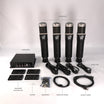Dynamic Scaling™ Algorithm
This is an algorithm developed to maximize the full stroke of the motion system.
First, we need to understand, that 1 degree of pitch, will use different amounts of travel, depending on the distance between the front and rear actuators (rig length). Also, 1 degree of roll will use different amounts of travel, depending on the distance between the left and right actuators (rig width). For the examples below, let's use a rig length of 30" and a rig width of 30".
Let's start with the common static allocation for a 3DOF 2" motion system. DK2 currently has four layers of pitch and roll (DK6 has 6 layers) and 1 layer of heave.
- Heave: 40% (0.8 inch)
- Surge to pitch (highlights pedal and shift inputs): 15% (+/- 0.57311 degrees, 0.3 inch)
- Sway to roll (highlights turning roll): 15% (+/- 0.57311 degrees, 0.3 inch)
- Environment pitch (real pitch): 15% (+/- 0.57311 degrees, 0.3 inch)
- Environment roll (real roll): 15% (+/- 0.57311 degrees, 0.3 inch)
- Total allocation: 40% + 15% + 15% + 15% + 15% = 100%
- Total travel allocated: 0.8" + 0.3" + 0.3" + 0.3" + 0.3" = 2.0"
The are 2 main issues with this approach:
- Each of the pitch & roll layer only has a range of +/- 0.57311 degrees, which is too little from our experience. As the rig dimensions get longer and wider, this range will get even smaller! i.e. At rig length of 49", the pitch range drops to +/- 0.35 degrees. To mitigate this, you can use less motion layers but that would be a huge compromise. Our research shows the importance of these four pitch and roll layers. Another approach is to reduce the heave allocation of 40% (0.8 inch). Unfortunately, this is also a huge compromise and we believe 0.8 inch is the absolute minimum.
- Not all the layers are fully active all the time, thus wasting precious travel space.
Solution
Our research shows that each pitch & roll layer needs an allocation of at least 1 degree. Hence, Sigma uses degrees to allocate travel. This approach also allows the motion experience to be identical regardless of the rig's length and width. i.e. same car, same track, same tuning setting, same braking force applied, will generate the same pitch in the rig, regardless of the rig’s length.
Here is the final allocation of the DK2 system for a rig with 30” length and 30” width:
- Heave: 40% (0.8 inch)
- Surge to pitch (highlights pedal and shift inputs): 1.00 degree (26.2%, 0.524 inch)
- Sway to roll (highlights turning roll): 1.25 degrees (32.72%, 0.6544 inch)
- Environment pitch (real pitch): +/- 1.25 degrees (32.72%, 0.6544 inch)
- Environment roll (real roll): +/- 1.25 degrees (32.72%, 0.6544 inch)
- Total allocation: 40% + 26.2% + 32.72% + 32.72% + 32.72% = 164.36%
- Total travel allocated: 0.8" + 0.524" + 0.6544" + 0.6544" + 0.6544" = 3.2872"
In other words, the system is over allocated (164.36%) and is comparable to a system with 3.2872" travel.
If the rig length is increased to 49", and the width stays at 30", here are the allocation results:
The system is over allocated (212.34%) and is comparable to a system with 4.2468" travel.
The dynamic-scaling-algorithm works on the four pitch and roll layers, which shares 60% of the physical travel, while the heave layer gets a dedicated 40% physical allocation. When the four pitch & roll layers exceed the physical space available, each of the four layers are dynamically scaled lower, so they fit the travel space. The result is the illusion of a much longer travel system.
The origin of this algorithm is from Sigma's full motion systems (commercial full-size vehicles) where the amount of travel required to make 1 degree of pitch, or 1 degree of roll, takes up almost the full travel of the system. A static allocation approach simply would diminish the motion experience, and the development of this dynamic-scaling-algorithm was absolutely critical.








